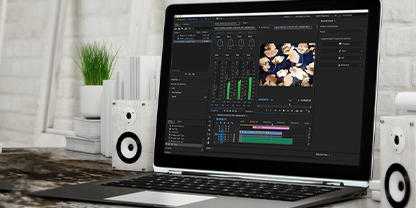Grab a microphone, some headphones, and fire up Adobe Audition – we’re going to podcast!
Download seagate software for mac. If you chop out anything in the middle of your show, you’ll need to do a different kind of DELETE – in Audition it’s called a RIPPLE DELETE. This will remove the selection and slide everything after it over so there is no gap.
- : Now, if you've got your audio interface hooked up in such a way you can actually play what you hear audio in, you should also be able to go into a new line here, transcribe using this podcast episode.: So let me hit transcribe. Hit the mike phone button again and I'm going to try playing my podcast episode.: Hello. I'm Mike.: I'm Isabella.
- Standard: Adobe Audition. A Audition is an all-around solid choice for editing your podcast. It has all the features you could need, a manageable learning curve, and a decent price point. This is a great option for a beginner to seasoned podcaster.
Let’s find a mess up in the show and ripple delete it. If you haven’t slid your tracks around, you should find it around the 31m,41s mark, right after Justin says “jump through those hoops” he starts mumbling and gives up on the thought and asks YOU THE LISTENER to cut it out. He really does mean you! Download a prior version of adobe reader on mac. He gets back on track at 31m57s.
Mar 26, 2020 Before you can record in Audition, you will first need to select the input source for the track that you would like to use. In this case, when using the Podcast template, you can use the Host track as your main recording track. Click the double arrows button above the track name panels to access the input/output selections.
Use the TIME SELECTION tool to select the region between those approximate times. Use the waveforms as your guide, and ZOOM IN if you need to!
select that mess up for a RIPPLE DELETE
Now let’s RIPPLE DELETE! Adobe publisher mac free download. Use EDIT > RIPPLE DELETE > TIME SELECTION IN ALL TRACKS to make this happen.
RIPPLE DELETE from the menu
Using Audition For Podcasting Software
You’ll want to make sure you use ALL TRACKS otherwise you’ll only delete one track’s area and pull it out of sync.
Now let’s slide our intro song in there to TRACK 3. If you PLAY it you’ll see it’s super loud compared to the voices! Let’s go ahead and turn it down using the track’s tools. You’ll find the VOLUME knob just under the TRACK NAME:
turn down that music!
-11dB is probably pretty good.
Next thing – I think the song ends too early. Justin doesn’t start speaking soon enough after it fades out. Let’s go ahead and MOVE our music to the right until it’s happily half-faded out as Justin starts the show:
the music has been moved to fade as Justin starts!
Using Audition For Podcasting Youtube
Now let’s RIPPLE DELETE this new 1.5sec gap we just created up front. Remember how? SELECT that 1.5sec region, then RIPPLE DELETE ALL TRACKS. You’re getting the hang of this!
TWO MORE THINGS:
1 – Let’s add the theme song to the end of the show. FN-RIGHT ARROW to the end and drag the song from the FILES tab onto Track 3 at the end. Place it where Justin wraps it up “Podcasting with Justin Edwards.” around 32m16s (if you chopped out that first 1.5sec).
the song repeated at the end
No need to adjust volume again, since the adjustment we made already changes it for every file that lives on that track.
2 – Speaking of adjusting volume levels, you may have noticed the discrepancy between JUSTIN and MIKE’s tracks – Justin is much louder than Mike. Go ahead and give Mike’s track a boost. 6dB should do.
A Word On EffectsWe should spend some time talking about EFFECTS – adjusting EQ, adding a COMPRESSOR and a LIMITER, but we are just about out of time here for an already long tutorial.
BUT THERE’S GOOD NEWS:
Using Audition For Podcasting Free

Listen to the sample podcast we’ve been working on. Mike gives a great overview of the effects he uses for his shows.
We also have our own tutorial on it here: Audition FX Tutorial
Let’s get your show out of Audition and into MP3 land! To export your session use the menu and go FILE > EXPORT > MULTITRACK MIXDOWN > ENTIRE SESSION
exporting through the menu
This will open the following window:
export window
We’ll want make some changes to their defaults.
- I like to export to my Desktop so the file is easy to find. Use BROWSE to do this.
- Change the FORMAT. Use the dropdown box to choose MP3.
- CHANGE the SAMPLE TYPE. This will open a window:
SAMPLE TYPE options
- Change the SAMPLE RATE from “Same as source” to 441000.
- Change the BIT DEPTH from “Same as source” to 16. Hit OK.
- Lastly, CHANGE the FORMAT SETTINGS. It will open this window:
MP3 FORMAT SETTINGS
- Change the BITRATE to 96Kbps. This is because we just have a one-channel MONO file. A stereo show would double this since it has two channels. Hit OK.
- Hit OK in the export window and Audition will do its thing!
Using Audition For Podcasting Youtube
Go find your file on the desktop. Voila! Congratulations, you’re a podcaster!
Using Audition For Podcasting Software
Special thanks to Michael Edwards of the Sunrise Robot podcast network for his guest spot in our tutorial files! You owe it to yourself to check out his shows at SunriseRobot.net.
